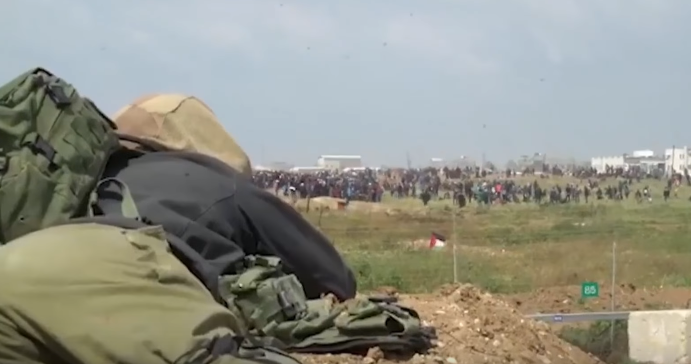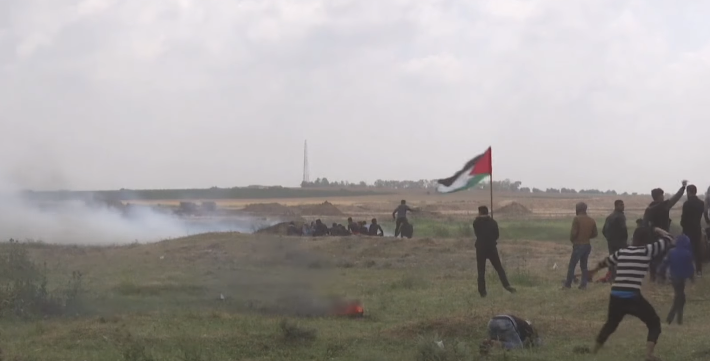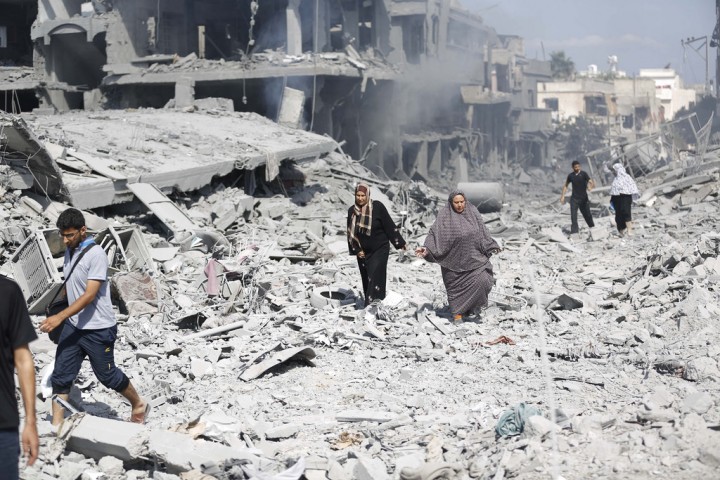While the attention of the international media is drawn to the threatened US airstrike on Syria, the Palestinian mobilisations for the right of return of refugees and the ruthless killing of demonstrators by the IDF (Israeli Defence Force) in the Gaza Strip continues.
The massacre carried out at the Gaza border by IDF snipers on 30th March – who killed 18 Palestinian demonstrators and injured several hundreds – and repeated on 6th April, is not an accident. It is the consequence of a conscious long-term strategy by the Israeli state aimed at strangling the livelihood of the more than 1.8 million Palestinians living in what can be effectively described as an open-air prison. This should not be taken as a polemical exaggeration: even UN Human Rights rapporteur John Dugard described Gaza as a “sealed-off, imprisoned and occupied territory”, of which Israel “appears to have thrown away the key”.
The recent scandal around the publication on social media of a video taken by an IDF soldier of a fellow sniper gunning down in December a Palestinian getting too close to the border fence is revealing – both of the IDF soldiers’ attitude and that of the Israeli government. The cheering at the sniper and the insults thrown at the wounded man – who may have succeeded in damaging the hated border fence before being killed – reveal inhuman and demented hatred at the “enemy” by the soldiers. But what is the background to all this? The ruthless attitude of the Israeli ruling class is represented by Defence minister Avigdor Lieberman, who said there were “no innocent” people in Gaza. He also commented: “The Gaza sniper deserves a decoration, and the photographer a demerit”, thus showing his utter contempt for Palestinian lives and at the same time his pique at being exposed by the insanity of his own soldiers, who fail to realise how their behaviour would not be regarded as monstrous.

It is not by chance that this episode resonates with the witnesses’ reports and the pictures taken by the US Army and CIA torturers of fellow-torturers smiling for the camera while performing the worst type of abuses on unarmed prisoners at the Abu Ghraib prison in Iraq. What these episodes have in common is not just the inhumane attitude of the material butchers, but the fact that the real responsibility for creating such monsters lies all the way up the chain of command, up to the highest levels of the army and the government in both cases. Occasionally, in order for the system to keep a resemblance of credibility, a few of these butchers are apprehended, tried and convicted, often labelled as criminal psychopaths and tossed away from public scrutiny, while the real instigators are left untouched.
The decision to deploy sharpshooters to enforce a no-go zone on the Gaza side of the border and to stop Palestinian attempts to breach into this zone during protests led inevitably to the massacres of Palestinian protesters on 30th March and 6th April, and to more massacres in the foreseeable future. The growing anger and determination of the Palestinian youth is finding a focal point in the movement around the “Great March of Return”, which will escalate towards the 70th Anniversary of the proclamation of the State of Israel (and the forced eviction of hundreds of thousands of Palestinians from their homes) on 15th May.
Israel and Gaza
But what is the logic behind such a conduct on the part of the Israeli government? Who gains from all this?
Gaza has been for decades – from the point of view of the Israeli state – an open wound festering at its border. On paper, it would be a wiser policy to allow the Palestinian population some breathing space. After all, even minor but sustained concessions and the easing of the economic stranglehold over the Territories would produce under the present situation an immediate improvement in the conditions of hundreds of thousands of Palestinians. But the whole foundation of Israeli capitalism would be threatened by a different course of action.
The Israeli capitalists base their survival strategy on dividing the Palestinian population in different camps and would be threatened by the formation of a unified struggle of the Palestinian population in the West Bank, East Jerusalem and Gaza with the 1.4 million Palestinians living within Israel. Even the slightest possibility that a connection could be established between the struggle of the Arab and Jewish working class within Israel against their capitalist government with the struggle of the Palestinians in the Territories would represent an existential threat to capitalism in Israel.
More than once and even now, the Palestinian population of the Territories has been used as a scapegoat to overcome internal divisions developing in Israeli society, with the ruling elite riddled by all sorts of corruption scandals and society polarised by rising inequality. Netanyahu’s aggressive anti-Palestinian policy is designed also to prevent his own demise, as he is trying to divert attention from the corruption scandals that have been plaguing his authority over the past years.

The result is clear. More than three years after the Gaza shelling of 2014, living conditions in the Strip have seen no improvement, with unemployment at 29% in the Palestinian Authority, but above 44% in Gaza and well above 60% among the youth, according to the World Bank. 80% of the population rely on humanitarian aid to survive. Over 70% of Gaza’s population are refugees (according to the UN Relief and Works Agency) from land now within the borders of Israel, which explains how heartfelt is the demand to return posed by the present movement. But the sense of hopelessness among the Gaza population, especially the youth, cannot be conveyed by mere figures, when hopes are shattered by a daily routine of oppression, abuse and injustice to which there seems to be no end in sight.
On the other hand, why is not Israel just going for an all-out war against the Palestinians? The disproportion of military power between the two sides is staggering. The IDF could easily crush any resistance in a matter of days, if not hours. The option of just occupying militarily the Strip, however, was ruled out as not feasible by the late Ariel Sharon, surely not a friend of the Palestinians, who in 2005 implemented the decision of forcefully withdrawing the Israeli settlers, disengaging from Gaza and sealing off the borders. In fact, Sharon realised that while the IDF could easily crush the Palestinian militarily, it would be a completely different question to rule over an occupied Gaza, and it would be impossible to push out a significant part of the Arab population without openly committing genocide in front of the world.
Gaza is a strip of land about 40 km long and 6 to 12 km wide, squeezed between Israel, Egypt and the Mediterranean Sea. It is the third most densely populated area enclosed in boundaries in the world (after Singapore and Hong Kong) with over 5,000 people per square km. An extensive Israeli buffer zone within the Strip renders much land off-limits to Gaza’s Palestinians. The population is expected to increase to 2.1 million in 2020. By that time, Gaza may be rendered unliveable, if present trends continue.
Due to the Israeli and Egyptian border closures and the Israeli sea and land blockade, the population is not free to leave or enter the Gaza Strip, nor is it allowed to freely import or export goods. Fishing has been restricted to up to 6 nautical miles. The Oslo Accords of 1993, which gave birth to the Palestinian Authority allowed fishing to take place within up to 20 nm.
Gaza depends on Israel for almost everything from food to medicines and hospital supplies, machinery and spare parts and fuel, energy and drinkable water. Israel controls Gaza’s telecommunication system, which could be shut down at any time. Deliberate cuts to electricity or water supply are a daily occurrence for which the people in Gaza pay a heavy price. Sudden closures of the border have an immediate impact and are often used by Israel as a blackmail weapon.
But there is another side to scarcity and misery. It strengthens the position of the Hamas leaders, whose patronage and charity structures are sometimes the only source of relief for the population.
The policies of the Israeli state are designed to feed a sense of desperation and helplessness in the population – especially the youth. This is the reason for the recurrent escalation in the level of mobilisation or military tension at the borders. The Hamas leaders can obviously count on a disproportionate reaction by the Israeli state to any friction or conflict arising, which helps them preserve their authority as the only force able to challenge Israel in the eyes of an important section of the people in Gaza. The very fact that the concrete possibility of being shot at and killed has not deterred the participation of tens of thousands of people in the demonstrations at the borders reveals the unbreakable determination of the Palestinian youth, which is also reflected in a rising pressure on the Hamas leadership to challenge the blockade.
The role of Hamas
The poisonous fruits of the Oslo Accords of 1993 are displayed before our eyes. The setting up of the Palestinian Authority (PA) was designed to be a trap for the Palestinians, to which the PLO and Fatah leadership, headed by Yasser Arafat obliged wilfully in exchange for a parody of semi-independent Palestinian state.
In reality, with the collaboration of the Palestinian leadership, the PA was turned more and more into a repressive proxy by Israel to keep the different Palestinian factions under check. Many Palestinians who were pushed into rebelling against a new form of oppression experienced Palestinian jails. The corruption of the leadership, constant Israeli intervention and the persisting misery for the majority of the Palestinian workers and youth exposed soon a different reality from the propaganda dreams of a bright future after the establishment of the PA.
 The constant threats of Israeli intervention helped Hamas in consolidating its grip over Gaza / Image: public domain
The constant threats of Israeli intervention helped Hamas in consolidating its grip over Gaza / Image: public domain
On a capitalist basis, the West Bank and above all Gaza could never experience an economic development on their own, also because Israel would simply not allow it. Only a small layer of the Palestinian elite enjoyed the meagre benefits of the new situation. Arafat’s promise to turn Gaza into a Singapore of the Middle East sounds now to many Palestinians as a cruel joke. Interestingly the Hamas leaders – who don’t have any real alternative to offer – are now echoing the same promise.
In 2005 Sharon decided Israel’s unilateral withdrawal from Gaza, but that did not mean for a moment that Israel decreased its pressure against the Palestinian population. The growing discontent against the PA and the Fatah leadership eventually brought about the 2006 election victory by the Islamic fundamentalist movement of Hamas, triggering the political division of the PA and the Israeli blockade of Gaza, which is still continuing. The horrendous crimes of the two Gaza “Wars” of 2008-09 and 2014 showed what the so-called peace process under the wings of US and European imperialism meant in practice. The first, denominated by the Israeli army “Operation Cast Lead” saw 1,400 Palestinians and 13 Israelis killed, not to speak of the thousands of injured and the destruction of large parts of the shaky Gaza infrastructure. The same scenario was repeated on even a bigger scale in 2014 (2,300 Palestinians and 73 Israelis killed). The very figures of the casualties are telling of the asymmetry of the firepower in these so-called wars.
The constant threats of Israeli intervention paradoxically helped Hamas in consolidating its grip over Gaza and achieve the internal suppression of most secular and socialist opposition. Now, 12 years later we are witnessing again the same mechanism at work.
The threat of Hamas has been skilfully used by the Israeli ruling class and by Netanyahu in particular as a means of consolidating their grip over society, after facing rising criticism and opposition to the austerity policies imposed by the government on the Israeli working class. Corruption scandals have undermined Netanyahu’s authority to a great extent and the still relatively small but significant demonstrations of tens of thousands of people over the past few months against the government policy on immigration and against corruption show that the potential for a stronger movement against the government exists.
The shooting of unarmed protesters in Gaza and the defiant attitude of the Palestinian youth has also undermined the credibility of the government.
The crisis of capitalism in Israel is creating the basis for further convulsions in the area, which will put on the agenda once again the need to unify the struggle of the Palestinians in Gaza and the Territories with the struggle of the working class and youth within Israel against the policy of austerity, war and class inequality ruthlessly imposed by the Israeli ruling elite.
See original here
